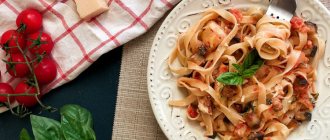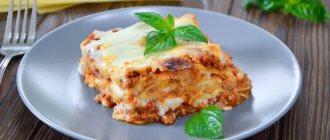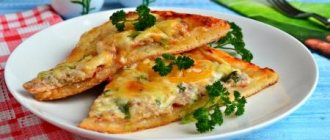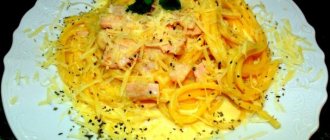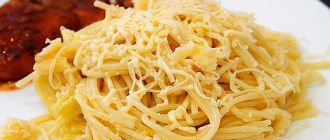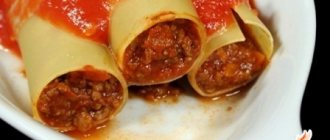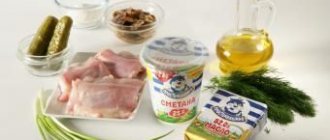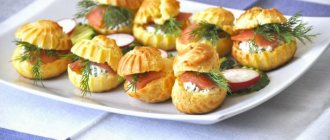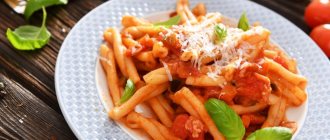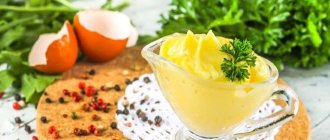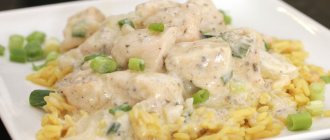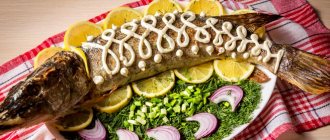Boiled pasta: technological map of the original and variations
Strange as it may sound, even for such a simple dish as boiled pasta, you need clear cooking instructions, in other words, a technological map. This is a mandatory document for those who work in the food industry, in particular in catering establishments, institutions or stores that have their own culinary department.
Boiled pasta
The technological map of a given culinary dish provides an indication of the proportions of the necessary products for its preparation, as well as a description of the sequential actions of the work itself.
If you are guided by basic standards, you can take the technological map below as a sample.
| Ingredient name | Gross quantity (g) for 1 serving | Net quantity (g) for 1 serving |
| Pasta | 60 | 60 |
| Water | 300 | 300 |
| Salt | 10 | 10 |
| Butter | 10 | 10 |
| Exit: | — | 200 |
Technological process of preparation
Bring salted water to a boil, add pasta and cook until tender. Cooking time can range from 4 to 20 minutes, depending on the total number of servings, type and size of pasta. As the pasta cooks, it expands approximately 3 times in size and requires constant stirring to avoid sticking. After the pasta is cooked, place it in a colander and add half the amount of melted butter, stirring thoroughly. The rest of the oil is added immediately before serving.
The shelf life of the dish is 2 hours from the moment it is prepared.
If it is customary for an establishment to prepare a certain type or grade of pasta, then the technological map for boiled pasta indicates a more precise cooking time.
Added a product - changed the dish
Even if you make minor changes to the dish, you get a new masterpiece. This feature is very important to take into account when drawing up menus and developing new technological maps, since this affects not only the taste (for the consumer side), but also the material side - costs (for the seller or performer side).
In particular, the technological map for boiled pasta with butter and boiled pasta in terms of ingredients are one and the same. But depending on the purpose of their use in the future, the cooking process itself will differ.
So, there are drain and non-drain methods. The first is used when pasta is prepared as an independent side dish. The second is used when cooking pasta for pasta dishes and casseroles.
Technological map of boiled pasta with vegetables
If you add vegetables to the dish, it turns out more satisfying, fresh and has a pronounced aroma.
In standard collections, the recommended technological map for boiled pasta, which is supplemented with vegetables, is as follows.
| Name of ingredients | Gross per serving (g) | Net per serving (g) |
| Ready-boiled pasta | 250 | 250 |
| Green peas | 31 | 20 |
| Fresh carrots | 25 | 20 |
| Tomato puree | 20 | 20 |
| Table margarine | 0 | 10 |
| Onion | 25 | 21 |
| Exit | 320 |
How to cook
All vegetables, except peas, are peeled, washed and cut into strips. Sauté in a heated frying pan until golden brown. After this, add tomato puree and sauté for another five minutes. At the same time, warm up the green peas. Add sautéed vegetables and warm peas to fresh prepared pasta (the technological map for boiled pasta is presented above) and mix. The dish is ready to be served.
It should be borne in mind that any changes to the components of the dish must be included in the technological maps.
fb.ru
Added a product - changed the dish
Even if you make minor changes to the dish, you get a new masterpiece. This feature is very important to take into account when drawing up menus and developing new technological maps, since this affects not only the taste (for the consumer side), but also the material side - costs (for the seller or performer side).
In particular, the technological map for boiled pasta with butter and boiled pasta in terms of ingredients are one and the same. But depending on the purpose of their use in the future, the cooking process itself will differ.
So, there are drain and non-drain methods. The first is used when pasta is prepared as an independent side dish. The second is used when cooking pasta for pasta dishes and casseroles.
Boiled spaghetti, semi-finished product (TTK1951)
Boiled spaghetti, semi-finished product (TTK1951)
TECHNICAL AND TECHNOLOGICAL CARD No. Boiled spaghetti, semi-finished product
This technical and technological map was developed in accordance with GOST 31987-2012 and applies to the Boiled Spaghetti dish, a semi-finished product produced by a public catering facility.
Food raw materials, food products and semi-finished products used for preparing dishes must comply with the requirements of current regulatory documents, have accompanying documents confirming their safety and quality (certificate of conformity, sanitary-epidemiological report, safety and quality certificate, etc.)
| Name of raw materials and products | Unit | Raw material consumption and | |
| products for | |||
| per 1 kg | |||
| Gross | Net | ||
| Spaghetti pasta | G | 480,000 | 480,000 |
| Refined vegetable oil | ml | 41,200 | 40,000 |
| Extra table salt | G | 10,000 | 10,000 |
| Yield (in grams): | 1000 |
Boil spaghetti in salted water with the addition of vegetable oil (20g) until al dente.
Drain the water, put it in a container, pour over the remaining oil and mix, cool so that it does not dry out and package it in 150g and 120g bags.
- REQUIREMENTS FOR DESIGN, SALE AND STORAGE
Serving: The dish is prepared according to the consumer’s order and used according to the recipe for the main dish. Shelf life and sales according to SanPin 2.3.2.1324-03, SanPin 2.3.6.1079-01 Note: the technological map was compiled on the basis of a development report.
- QUALITY AND SAFETY INDICATORS
6.1 Organoleptic quality indicators:
Appearance - Characteristic of this dish.
Color - Characteristic of the products included in the product.
Taste and smell - Characteristic of the products included in the product, without any foreign tastes or odors.
6.2 Microbiological and physico-chemical indicators:
In terms of microbiological and physicochemical indicators, this dish meets the requirements of the technical regulations of the Customs Union “On the safety of food products” (TR CU 021/2011)
- FOOD AND ENERGY VALUE
| Dishes | boiled paghetti with/ | on | 1 kg |
| output 1000 | |||
| Squirrels, | Fats, | Carbohydrates, | Calorie content |
| G | G | G | kcal |
| 16,320 | 41,440 | 114,240 | 895,200 |
Technological engineer:
technolog.com
Navy pasta
- Boil pasta according to package instructions.
- Finely chop the onion and crush the garlic. Heat oil in a frying pan and fry vegetables for 5 minutes. Add the minced meat and cook for 10-12 minutes, breaking up any lumps with a spatula.
- Add tomato paste, stir and heat for 2 minutes. Pour in 0.5 cups of hot water, salt and pepper to taste, simmer for 5 minutes.
- Drain the pasta in a colander and transfer it to the frying pan with the minced meat, cook all together for 5 minutes.
- Before serving, you can sprinkle with grated cheese and fresh herbs.
Bon appetit!
Recipe author: Muchacha
Ingredients for the Navy Pasta recipe:
- Tomato paste - 2 tbsp. l.
- Vegetable oil - 2 tbsp. l.
- Salt (to taste) - 2 gr.
- Black pepper (to taste) - 2 gr.
- Water - 0.5 tbsp.
- Pasta - 300 gr.
- Onion - 1 pc.
- Garlic - 2 teeth.
- Ground beef - 600 gr.
Nutritional value of the dish “Navy-style pasta” (per 100 grams):
Calories: 249.2 kcal.
Proteins: 11.8 g.
Fat: 13.4 g.
Carbohydrates: 19.5 g.
Number of servings: 4
This is a custom recipe, so there may be errors and typos. If you find them, please write them in the comments below the recipe and we will correct them.
Step-by-step recipes with photos from our website are in the “Recipes” section.
Liked? Rate it and save it on your social network page!
www.calorizator.ru
Navy pasta: recipe with beef stew
Dish: Main course
Cooking time: 30 minutes
Total time: 30 minutes
Servings: 5 servings
How to cook pasta navy style with stewed meat and tomato paste
1. Heat water in a large saucepan and add salt. Cook the pasta as usual.
The cooking time for pasta is indicated on the package. Drain all the water from the finished pasta.
2. Chop the onion. Fry it in oil and add a spoonful of tomato paste to it.
3. Open the can of stew.
Place the contents in the pan with the onions and tomato paste. Warm everything together for 6 - 7 minutes.
4. Place meat in pasta.
A simple, but very tasty and nutritious dish, navy-style pasta with stew and tomato paste is ready.
Bon appetit.
Naval pasta is prepared quickly and easily, and turns out very tasty and satisfying. A great dish for a family lunch or dinner! My dad loves this dish very much.
Pasta with vegetables with sauce, semi-finished catering product (TK1505)
Pasta with vegetables with sauce, semi-finished catering product (TK1505)
Process card No. Pasta with vegetables with sauce, semi-finished catering product (CP-recipe No. 154)
Publishing house Kyiv "A.S.K" 2005
Food raw materials, food products and semi-finished products used for the preparation of semi-finished pasta with vegetables with sauce must comply with the requirements of current regulatory and technical documents, have accompanying documents confirming their safety and quality (certificate of conformity, declaration of conformity, quality certificate, etc.) .
The preparation of raw materials is carried out in accordance with the recommendations of the Collection of technological standards for public catering establishments and technological recommendations for imported raw materials.
| Name | Raw material consumption per serving, g | ||||
| Gross weight, g | % when cold processed | Net weight, g | % during heat treatment | Output, g | |
| Pasta | 245,0 | 0,00 | 245,0 | 286.00 — weld | 700,0 |
| Water | 1500,0 | 0,00 | 1500,0 | 100,00 | 0,0 |
| Salt | 12,0 | 0,00 | 12,0 | 100,00 | 0,0 |
| Butter | 20,0 | 0,00 | 20,0 | 30,00 | 14,0 |
| Peeled baked bell pepper, semi-finished | 70,0 | 0,00 | 70,0 | 0,00 | 70,0 |
| Baked eggplant, peeled, semi-finished | 50,0 | 0,00 | 50,0 | 0,00 | 50,0 |
| Blanched tomato, semi-finished | 79,0 | 0,00 | 79,0 | 37,00 | 50,0 |
| Bechamel sauce, semi-finished | 100,0 | 0,00 | 100,0 | 20,00 | 80,0 |
| Hard cheese | 43,0 | 3,00 | 41,0 | 20,00 | 33,0 |
| Dill | 6,0 | 50,00 | 3,0 | 0,00 | 3,0 |
| Exit | 1000 g |
Pasta (pasta, noodles, vermicelli, etc.) is cooked in a large amount of boiling salted water (for 1 kg of pasta, take 6 liters of water, 50 g of salt). Cook pasta for 20-25 minutes, noodles for 18-20 minutes, vermicelli for 10-12 minutes. During the cooking process, pasta swells, absorbing water, as a result of which its mass increases by about 3 times, depending on the variety.
Place the cooked pasta in a colander and mix with melted butter so that it does not stick together or form lumps.
Baked peeled bell peppers are cut into 1x1 cm cubes, baked peeled eggplants are cut into small slices. Blanched tomatoes are cut into 1x1 cm cubes. Hard cheese is grated. The dill is sorted, washed, dried, and finely chopped.
Cooked pasta is combined with Bechamel sauce, chopped vegetables, and grated cheese. Bake in a steam convection oven at a temperature of 160* C for 10-15 minutes, “Heat” mode. The baking time depends on the volume of the baked product. Ready pasta is portioned. When leaving, sprinkle with finely chopped dill.
- Characteristics of the finished dish, semi-finished product
Appearance – cooked pasta mixed with Bechamel sauce, chopped baked vegetables, grated cheese. Pasta is heated with sauce and vegetables, sprinkled with chopped dill. The pasta retains its shape and the vegetables remain soft.
Taste is characteristic of the ingredients included in the dish, without any extraneous taste.
Smell – characteristic of the ingredients included in the dish, without any foreign odor.
- Requirements for registration, sale and storage
Pasta with vegetables and sauce is prepared according to the menu. Heat treatment is carried out immediately before delivery. They are not stored in finished form. Semi-finished products included in the dish may be subject to short-term storage. The shelf life for these semi-finished products is determined in accordance with SanPin 42-123-4117-86, and is indicated in the relevant technical and technological maps.
Pasta with vegetables with sauce must comply with the requirements of SanPiN SanPin 42-123-4117-86.
technolog.com
Technological process of preparation
Bring salted water to a boil, add and cook until tender. Cooking time can range from 4 to 20 minutes, depending on the total number of servings, type and size of pasta. As the pasta cooks, it expands approximately 3 times in size and requires constant stirring to avoid sticking. After they are cooked, they are thrown into a colander and seasoned with half the norm of melted butter, mixing thoroughly. The rest of the oil is added immediately before serving.
The shelf life of the dish is 2 hours from the moment it is prepared.
If it is customary for an establishment to prepare a certain type or grade of pasta, then the technological map for boiled pasta indicates a more precise cooking time.
Navy pasta
For: 5 people
Total cooking time: 40 min. Below in the table: quantity of necessary products, prices, calorie calculator. Data can be changed and recalculated. |
| Recipes with calories and prices | Products | Diets: overview of the main ones |
Today: February 16, 2012 Thursday - 00:55:22 Moscow time What can you cook quickly? How to calculate the cost of each dish? Where can I find calories? The answers are here! Delicious dishes with calories and prices: you can download for FREE, WITHOUT registration or sending SMS. All culinary recipes with photos. Volumes: 1 teaspoon (tsp) = 5 ml. 1 tablespoon(tbsp) = 15 ml. 1 glass = 200 ml.
www.2000diet.ru
Navy pasta with boiled beef in a slow cooker
Ingredients:
- boiled beef 400g;
- pasta 300g;
- onion 1 pc.;
- butter 20g;
- vegetable oil 20ml;
- parsley;
- ground black pepper;
- salt.
Preparation:
Pass the finished boiled beef through a meat grinder or finely chop it.
Place durum pasta in a slow cooker, add salt, and pour in boiling water.
The liquid should cover the contents of the container.
Put a piece of butter.
Cook in “Pasta” mode.
Pour vegetable oil into a frying pan, fry the chopped beef and chopped onions.
Wash the pasta, put it in a slow cooker, add minced meat.
Mix the products, heat and serve.
Navy pasta (one of the options) | Soviet public catering
Hot dishes and side dishes from legumes, cereals, pasta
Navy-style pasta is a tasty, easy-to-prepare dish. Surely everyone knows how to cook navy pasta. But on a website dedicated to Soviet cooking, there simply must be a recipe for this dish.
For this dish you can use different types of meat - beef, pork, lamb, chicken, turkey - but the classic recipe recommends using beef.
In our opinion, the most delicious navy-style pasta is obtained if you use minced raw meat.
Navy pasta. Recipe
Ingredients (for 4 servings):
pasta – 350 gr.;
beef or prepared minced meat – 300 gr.;
onion – 1 pc.;
meat broth or water – 100 ml;
salt, oil, ground black pepper - to taste.
Preparation:
Cook the pasta until tender (according to the instructions on the package).
Pass the meat through a meat grinder.
Fry the onion, cut into small cubes, in oil, add the minced meat and stir vigorously so that no lumps form in the minced meat, fry until the color changes. Pour in meat broth or water, add salt and simmer for 15-20 minutes.
Add boiled pasta to the stewed minced meat with onions, pepper, add salt if necessary, stir and keep on fire for another 3-5 minutes.
And even with such a simple and uncomplicated dish as navy-style pasta, red table wine, for example this one, is perfect:
{October 3, 2013} {Tags: hot dishes, pasta}
sov-obshchepit.ru
see also
- Zucchini caviar with garlic and mayonnaise for the winter
- Hazel grouse recipe in the oven
- Preparing salads for the winter with cucumbers
- Lavash rolls with fish
- Crochet patterns diagrams and descriptions for beginners
- Whole bell pepper for the winter - the best recipe
- How to cook cheesecakes in the oven
- Pickled tomatoes without rolling up the jars
- Recipe for hot sausage sandwiches
- What to cook deliciously from catfish photo
- Wheat mash without yeast
